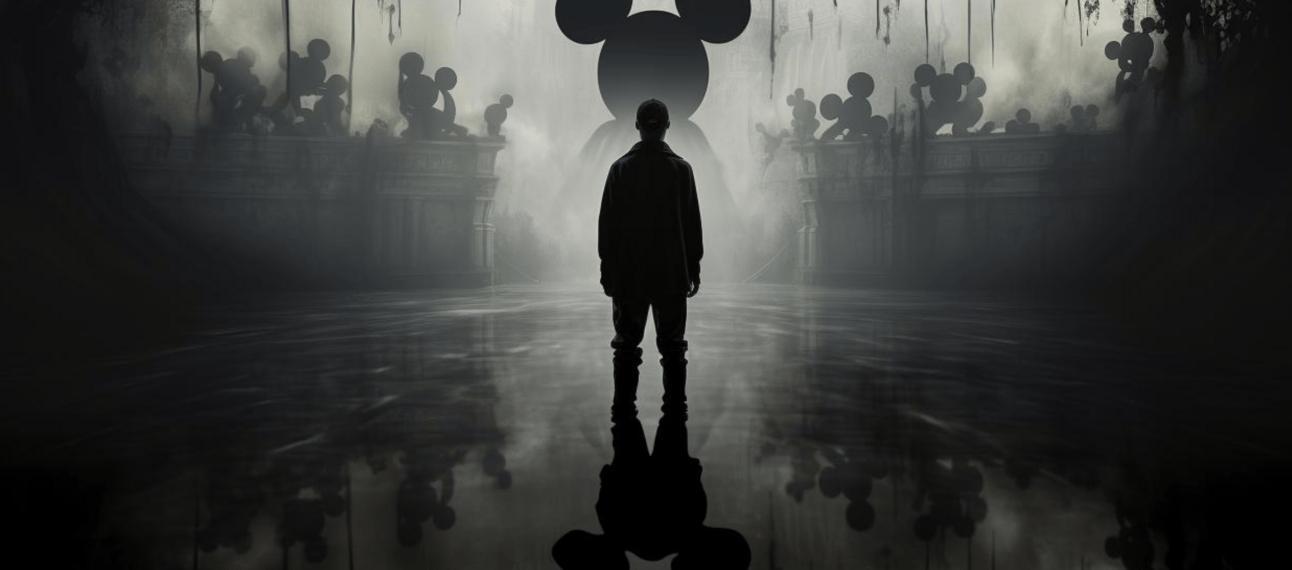
“Steamboat Willie (film) The first Mickey Mouse cartoon released, and the first cartoon with synchronized sound. Directed by Walt Disney. After unsuccessfully trying to make a deal to record through RCA or Western Electric, Disney contracted with the bootleg Powers Cinephone process and, after an initial disastrous recording session, finally recorded the sound track with a 15-piece band and his own squeaks for Mickey. Released at the Colony Theater in New York on November 18, 1928, the date used for the birth of Mickey Mouse. As a mischievous deckhand on a riverboat, Mickey, to Minnie’s delight, plays “Turkey in the Straw” utilizing an animal menagerie as his instruments. The tyrannical Captain Pete is not amused, and Mickey ends up peeling potatoes in the galley. Later released on the 16mm compilation Milestones in Animation (1973).”
In the world of intellectual property, few characters are as iconic and beloved as Mickey Mouse. For almost a century, Mickey Mouse has been synonymous with Disney and has captured the hearts of audiences worldwide. However, the relationship between Mickey Mouse, Disney, and the public domain is an intriguing love triangle that raises questions about copyright, trademark, and creative reuse. In this article, we will explore the impending entry of Mickey Mouse into the public domain, the possibilities and limitations of using the character, and provide a clear understanding of usage rights and caveats.
When it comes to using Mickey Mouse and other public domain characters in new creative works, there are certain guidelines to keep in mind.
You can use the original versions of Mickey and Minnie Mouse, as they appeared in the early cartoons like Steamboat Willie and Plane Crazy, in your new creative works. Even though these characters also appear in more recent copyrighted works, copyright expiration allows you to use them in new works.
However, with newer iterations of Mickey and Minnie, Disney only owns the original, creative expression that qualifies for copyright protection. Mere ideas, unoriginal features, and "merely trivial" variations to the original characters are not eligible for copyright protection. So, you can use generic character traits and features that are not copyrightable.
It's important to note that trademark law also comes into play. Disney retains trademark rights over Mickey, including the images of Mickey and the words "Mickey Mouse," for various products. Trademark law prohibits the use of trademarked characters if it is likely to cause confusion about the source or sponsorship of the new product. However, trademark law does not prevent you from using the 1928 Mickey character unless consumers will be misled into thinking your work is produced or sponsored by Disney.
If you want to use the Mickey character in a new cartoon or book, as long as it is clear that your work is not produced or sponsored by Disney, there should not be a trademark problem. Trademark law is focused on preventing consumer confusion, not interfering with creativity.
In summary, you can use the original Mickey and Minnie Mouse characters from the early cartoons in new creative works. You can also use later material that does not qualify for copyright protection, as long as it meets the threshold requirements for protect-ability. However, when using trademarked characters, it is important to avoid misleading consumers about the source or sponsorship of your work.
Usage Rights and Caveats
To summarize the usage rights and caveats for incorporating Mickey Mouse into new creative works:
You can use the original Mickey and Minnie Mouse characters from the early cartoons, such as "Steamboat Willie" and "Plane Crazy," in your projects as they enter the public domain.
For later iterations of Mickey, only the original, creative expression that qualifies for copyright protection is owned by Disney. Generic character traits and features that are not copyrightable can still be used.
Trademark law prohibits the use of trademarked characters if it may cause confusion about the source or sponsorship of the new product. However, using the 1928 Mickey character is permissible as long as it is clear that the work is not produced or sponsored by Disney.
It is crucial to avoid misleading consumers and respect Disney's trademark rights over the character.
This information is not official legal advice, and consulting with a legal professional is recommended for specific concerns or questions regarding the use of copyrighted or trademarked material.
Conclusion
As Mickey Mouse enters the public domain, it marks a significant milestone in the realm of intellectual property. The love triangle between Mickey Mouse, Disney, and the public domain showcases the delicate balance between copyright protection, trademark rights, and creative reuse. Artists and creators now have the opportunity to draw inspiration from the original Mickey Mouse character while respecting the boundaries set by trademark law. Let us celebrate the rich history of Mickey Mouse, honor the public domain as a wellspring of creativity, and continue to create new works that captivate audiences for generations to come.
Please note that this is not official legal advice. If you have specific concerns or questions regarding the use of copyrighted or trademarked material, it is recommended to consult with a legal professional.
References: